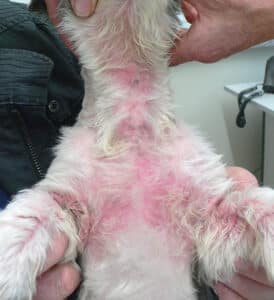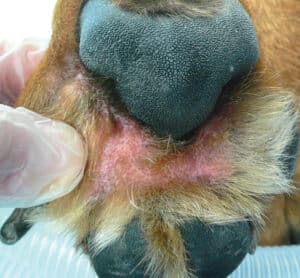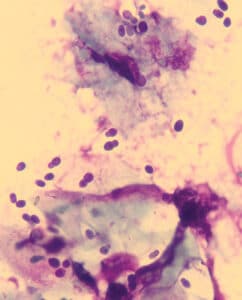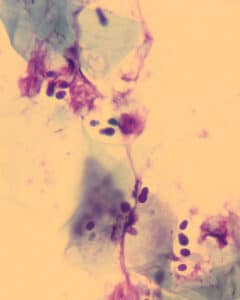What is Malassezia?
Malassezia are species of yeast that colonise the surface layers of the skin in healthy dogs and cats. They have a mutually beneficial relationship with the many species of bacteria that also colonise the skin surface. The most common species found on dogs and cats is Malassezia pachydermatis, and this is commonly found on the skin, in the ear canals and on the mucosal surfaces (oral, anal, vaginal) of normal dogs and cats. For the vast majority of animals, these yeast organisms cause no harm. However, when numbers multiply, inflammation of the skin can result.
Why does Malassezia sometimes cause disease?
There are a number of theories for why normally harmless yeast result in skin disease (dermatitis). Increased humidity is likely to be involved, as Malassezia dermatitis is more common in humid climates and in certain anatomical locations such as the ear canals and skin folds. Increased amounts of nutrients and growth factors for the yeasts are also probably involved, as animals with underlying scaly and greasy skin disorders, hormonal disease and allergic skin disease are more likely to suffer from the problem. Additionally, some breeds of dog seem particularly susceptible to Malassezia dermatitis so genetics could also have a part to play. Breeds such as Bassett Hounds, American Cocker Spaniels, Boxers and West Highland White Terriers all seem to be at higher risk for the disease. In cats, the Devon Rex breed seems particularly susceptible.
What effects does Malassezia have on dogs and cats?
Malassezia dermatitis is a common problem in dogs. It usually presents with itchy, scaly and inflamed skin at sites such as the lips, ear canals, neck, armpits, between the toes and in the skin folds around the face (Figures 1 and 2). Many dogs experience greasy skin with an offensive and distinctive odour. When dermatitis has been present for some time, the skin becomes thickened and frequently darkens due to excessive pigmentation. Malassezia infection can also result in a reddish-brown discolouration of the claws.

Figure 1: A dog with Malassezia dermatitis on the neck and forelimbs

Figure 2: The interdigital skin of a dog with Malassezia dermatitis
Malassezia dermatitis is an uncommon disease in cats. When present, it frequently causes itchy, scaly and inflamed skin in the ear canals, facial skin folds, claws and chin. In some cases, it can present with a generalised greasy and scaly dermatitis that is often secondary to serious internal disease. Cats with this presentation should undergo extensive investigations to look for an underlying cause.
How is Malassezia diagnosed?
The clinical signs of Malassezia dermatitis can look similar to a whole host of other skin diseases. For this reason, diagnosis cannot be achieved without performing tests. The most useful test to perform is to take a swab or sticky tape sample (tape impression) from the skin for staining and examination under a microscope. This allows examination of the material from the skin surface and assessment of the numbers of microbes on the skin. As Malassezia organisms are present in normal healthy animals, finding low numbers or occasional yeasts is not significant. However, in cases of Malassezia dermatitis, yeasts can be present in their thousands, and are often associated with inflammatory cells. Malassezia appear as peanut-shaped structures under the microscope and are usually purple/blue in colour due to the staining used for examination (Figures 3 and 4).

Figure 3: Peanut-shaped Malassezia yeasts seen through a microscope in a case of Malassezia dermatitis

Figure 4: Peanut-shaped yeast organisms seen through a microscope in a case of Malassezia dermatitis
How is Malassezia dermatitis treated?
Treatment of Malassezia dermatitis aims to lower the numbers of yeasts down to normal levels again. It is also vital to address any underlying triggers for why the yeast numbers increased in the first place. Various topical products are available and are the treatments of choice in compliant patients. Anti-fungal shampoos are the mainstay of treatment for Malassezia dermatitis affecting the skin, and are usually very effective. When shampooing is not possible, anti-fungal wipes, rinses and creams can be effective. Anti-fungal medications are also common components of medicated ear drops to use for dogs and cats with Malassezia infections in their ears.
In rare cases, it may be necessary to use oral medication to treat Malassezia dermatitis. These drugs are not licensed in the UK for the treatment of Malassezia in dogs or cats so should be reserved for cases not responding to other treatments.
Recurrence of the problem is very common unless the underlying trigger has been identified and corrected.
If you have any queries or concerns, please do not hesitate to contact us.
Arranging a referral for your pet
If you would like to refer your pet to see one of our Specialists please visit our Arranging a Referral page.